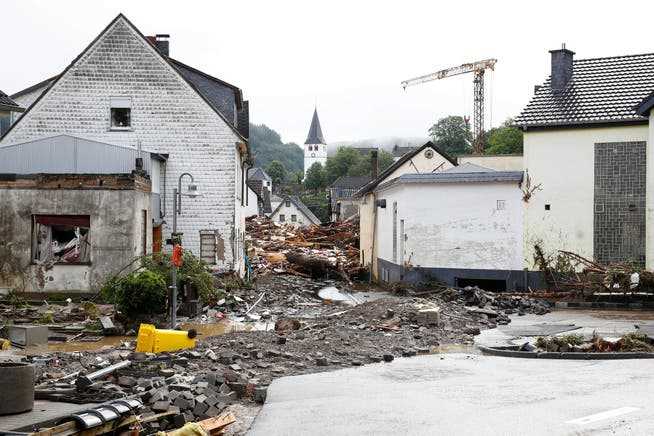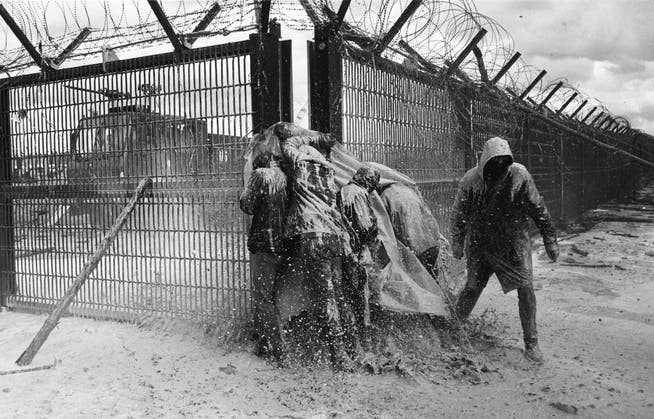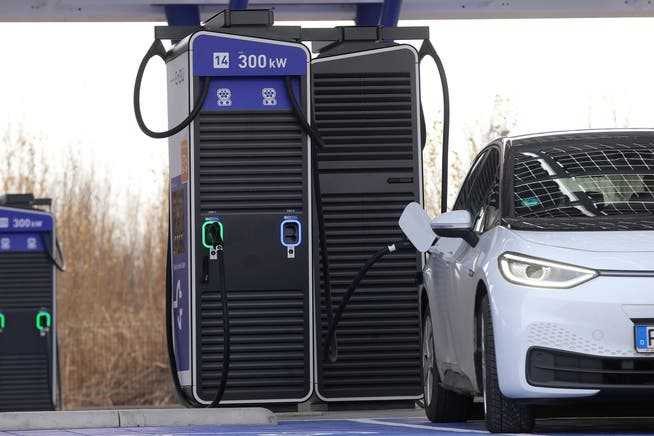The other way of looking at the climate debate
You are reading an excerpt from Kalina Oroschakoff’s “Planet A” newsletter. “Planet A” is about climate change and its effects on our lives, our work, our future. You can subscribe here. And here you can see what you’ve missed so far.
Topic of the week:
When is climate change to blame for environmental disasters?

After the flood in the Ahr valley disaster area in July of this year.
Extreme weather has shaped this year and certainly also directly affected one or the other “Planet A” reader. They will almost certainly keep us busy in the new year.
What rising temperatures can already mean for our lives today has long been a marginal topic in public discourse that has been neglected, even for journalists like me. That is changing now. Climate change has arrived in the heart of Europe. Today, terms such as adaptation and climate damage are no longer just talking points on the agendas of Pacific island states and other developing countries, which are wrestling for attention to their fate at the world climate conferences.
In Europe, too, more and more people, whether mayors, entrepreneurs or farmers, have to grapple with how to live with rising temperatures.
Thus announced the Mayor of Athens, Kostas Bakoyannis, in July the appointment of Europe’s first “Chief Heat Officer”. Eleni Myrivili is supposed to ensure that the city’s residents can (survive) even in brutal heat.
At the same time, extreme heat waves struck parts of the USA and Canada, leaving forests, roads and houses on fire. In other places there were tidal waves, storms, droughts. In Siberia were Record temperatures measured. Hardly a month this year went by without terrible news. Europe was not spared either: the floods in the Ahr Valley, which broke through the region in western Germany in mid-July, killed 134 people. Even today, many residents cannot return to their homes, the region fights with the consequences.
And the question kept coming up: Is climate change to blame?

Friederike Otto worked at the Environmental Change Institute at the University of Oxford until she moved to the Grantham Institute at Imperial College London in October.
The German climate scientist Friederike Otto is there when journalists want to have exactly this question answered. Otto founded the “World Weather Attribution” initiative (WWA) in 2014, together with the Dutch climate researcher Geert Jan van Oldenborgh, who died in October.
As the name suggests, the international research group wants to submit a scientific assessment as soon as possible after extreme weather conditions as to whether and to what extent man-made climate change had an impact.
“We’re doomed” – really?
This is a service for politicians and the public – especially the media. Because they quickly lose their interest in such extreme weather events, wrote WWA researchers in May. That is why it is “just important to make this type of scientific evidence available quickly” and to draw a realistic picture of the consequences of climate change while the public discussion is still raging, Otto tells me.
The public presentation has become significantly better, but after the man-made climate change was originally denied, the debate then turned into “everything is climate change” and “we’re doomed” (we are lost), especially in Germany, says Otto :
“This rhetoric has become very independent, and of course it always sounds as if climate change means that the physical world will become uninhabitable or perish, which of course is not the case.”
After the German flood disaster, WWA researchers found that extreme rainfall like in the Ahr region, viewed on a single day, was caused by climate change probable by a factor of 1.2 to 9r have become. One reason for this: warmer air can absorb more water vapor.
In addition, the consequences are not only due to the rain, but also to the geographical conditions, writes my colleague Sven Titz in this very readable piece to explain. In sections, the Ahr valley resembles a canyon in which rainwater collects particularly quickly. Precipitation of the same strength had also fallen in the Uckermark two weeks earlier, Otto told him in a separate conversation. While only a few streets got wet there, there were pictures of total destruction from the Ahr valley.
Scientists on the climate offensive
The year 2021 brought the breakthrough for so-called attribution research, including the recent report of the UN Climate Council IPCC, which was published in August, gave the topic a prominent place for the first time, as Sven writes. Otto is one of the main authors of the relevant chapter – and today one of the most sought-after faces of a young and new generation of climate scientists.
Time Magazine recorded Otto and van Oldenborgh in September his list of the world’s 100 most influential people of the year. She was surprised, said Otto in a conversation with Sven and me shortly after the appointment. There is “a bit of wishful thinking behind it” with the magazine. But attention is important:
“We founded World Weather Attribution to bring climate science into the public debate,” says Otto. It was about going on the offensive and changing society. Of course it’s political. But that doesn’t make her any less of a scientist just because she interprets her work.
Solutions need knowledge
Because what is still lacking understanding, especially in social discourse, is “what climate change – that is, doing nothing – has already cost so far”. Here it is important to get an overview.
“We don’t have an inventory of the damage caused by climate change,” says Otto. There are metrics and data on emission reductions, but in the case of damage there is “nothing remotely comparable”.
Environmental organizations often try to fill such gaps, also in order to back up their concerns and demands with figures.
For example the annual report of the British aid and development organization Christian Aidwhich was released on Monday. He found that the ten most violent extreme weather events of the year had each caused at least $ 1.5 billion in (insured) damage. The costs that have been increased by man-made climate change are in fact probably even higher, according to the report.
The economically most devastating were Hurricane Ida in the USA with 65 billion US dollars and the floods of the century in Western Europe with 43 billion US dollars. Floods, storms and droughts would also kill or displace millions of people, especially in regions that have hardly contributed to climate change.
This also deeply frustrates Otto. For them, the great challenge of climate change is “that it increases inequality in society”. In the end, it is always those “at the bottom of society with the fewest resources, the least information” who are hit the hardest. In doing so, climate change is also wiping out all developments aimed at counteracting vulnerability to damage and inequality, warns Otto. In their work, the researchers at WWA also focus on the need to adapt to extreme weather conditions.
Ask to checkout
Attribution science could play a major role here – by supporting the demands of many countries for adequate climate finance with data. Because international climate policy is primarily about money. And as was clear from the climate conference in Glasgow a month ago, the focus is increasingly on money for adaptation to the inevitable and unstoppable effects of climate change.
This will also have a major impact on 2022, when diplomats, climate activists and industry representatives meet in Egypt for the next climate conference in November. Because the COP27 summit will be in the name of climate damage and adaptation.
Agenda: what is still important

The last nuclear power plant is scheduled to go offline in 2022. This also marks the end of an eventful era in German history. On Easter Monday in 1986, for example, demonstrations broke out against the construction of the WAA reprocessing plant in Wackersdorf in Bavaria, and the police used CS irritant gas against the activists in disputes.
Atomic free: On Friday go three of the last six Nuclear power plants in Germany off the grid, the end of an era is getting closer and closer. While environmental organizations like BUND welcome this, the CDU thinks different tones. The CDU chairman Friedrich Merz said about the editorial network Germany on Monday that nuclear power does not have CO2 produce, «and for that reason alone France is in the CO2-Avoid so much further than we do ».
Electrified: There is more and more charging infrastructure for electric cars in Germany: Currently, a total of 50 901 publicly accessible charging points are reported, announced the Federal Network Agency a few days ago. That is around 11,600 charging points more than in the same month last year and a big leap forward compared to 2019. At that time it was 28,671.
Battery-fond: The federal energy agency Dena reported meanwhile, more and more people in Germany are deciding against an internal combustion engine and in favor of alternative drives. Almost half of all new car registrations are such vehicles. Despite the general slump in sales in the automotive industry, its market share doubled from January to October to 41.2 percent compared to 2020. According to the agency, over 530,000 new electric cars were registered by November.
The goal of the new federal government is meanwhile to have 15 million electric vehicles on Germany’s roads by 2030. In August, the Ministry of Economic Affairs announced that one million electric vehicles had been registered so far.
Wooded: Times are tough for forest owners. Climate change is affecting trees. At the same time, the Federal Government would like the forest to play an increasingly important role in the fight against climate change. My colleague Anja Stehle wrote this report, which is worth reading, about how private forest owners deal with this challenge.

Shop in North Rhine-Westphalia. According to its own statement, the energy company EnBW opened one of the largest public fast-charging parks in Europe for electric cars there this month.
On Farewell:
You can use this newsletter subscribe here.
